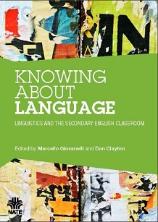
Resources for teachers of secondary English Language
Our research on the English Language is relevant to many areas of the KS3-5 curriculum, and especially to A level English Language content including language diversity and language change and language acquisition, as well as analysis of spoken texts (conversation analysis) and forensic speech science.
 |
Some of the ‘myth-busting’ research on English Language carried out in our Department is highlighted in a new book: Knowing about Language: linguistics for the secondary English classroom (edited by Marcello Giovanelli and Dan Clayton). In the chapter on 'Phonetics and Phonology', jointly written with experienced secondary English teacher Ian Cushing, Sam Hellmuth uses recent research from our Department to critically explore three topics for use as extension activities in exam-oriented work for A level English Language and/or as the starting point for Language Investigations or Extended Projects. On this page we provide links to the original research papers, and to other resources and sources of additional data. |
Myth 1: Child-directed speech is simpler than adult-directed speech
The basic idea: Child-directed speech (CDS) is often thought to be simpler than adult-directed speech (ADS), and in some ways it is. However, it turns out that CDS isn’t sociolinguistically simpler. Instead, care-givers were found to use local variants (e.g. a Tyneside pronunciation of /t/) in ways that reflected the range of variation found in adult speech:
“a child doesn’t just need to learn how to produce (t), she also needs to learn when to produce which sort of (t) in her community” [p.97].
The research: Foulkes, P., Docherty, G., & Watt, D. (2005). Phonological variation in child-directed speech. Language, 177-206.
A short version of the paper is available to download in full: Watt, D., Docherty, G. J., & Foulkes, P. (2003, August). First accent acquisition: a study of phonetic variation in child-directed speech. In Proceedings of the 15th International Congress of Phonetic Sciences (pp. 1959-1962).
Sources of more data: You can find recordings of child directed speech in the Talkbank on CHILDES. Click on individual corpora (in the left-hand menu) and then on individual files, to find the ones with accompanying sound and/or video, such as 'Eng-UK-MOR/Thomas/' or 'Eng-UK/Forrester/'.
Myth 2: All children produce the same sounds in babble
The basic idea: All children go through roughly the same stages in phonological development, one of which is the babble stage – but the exact set of sounds found in babble varies from child to child, and the set of sounds that a child produces in babble is shown in this research to influence the child’s perception of sounds in speech around them:
“children are not just learning to produce sounds during the babble stage […] during this stage the child is picking up on the match between the sounds she produces and the sounds she perceives in the speech around her” [p.98].
Research paper: DePaolis, R. A., Vihman, M. M., & Keren-Portnoy, T. (2011). Do production patterns influence the processing of speech in prelinguistic infants? Infant Behavior and Development, 34, 590-601.
Read more about this study and others on the webpage of the York Babylab.
Sources of more data: again, you should be able to find recordings containing babble in the Talkbank on CHILDES
Myth 3: You can identify a speaker’s voice using software
The basic idea: Although we sometimes see 'voiceprint' technology - used by James Bond or Jack Ryan - in fiction, in real criminal investigations, in the UK, at present, expert auditory analysis by phoneticians is still a critical component of forensic speaker comparison casework:
"the basic task of identifying the typical features of regional accents lies at the heart of all UK forensic speaker comparison work" [p.99]
Research paper: French, P., Nolan, F., Foulkes, P., Harrison, P., & McDougall, K. (2010). The UK position statement on forensic speaker comparison; a rejoinder to Rose and Morrison. International Journal of Speech Language and the Law, 17, 143-152.
Read some real forensic speaker comparison case studies on our forensic speech science pages.
Useful links: a fictional voice-activated door access system in a James Bond film [at about 3.54s].
